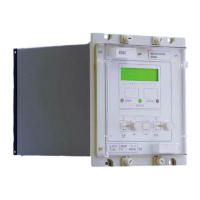Manual
KVCG202/EN M/H
This test checks the runaway protection feature which monitors the tap position to check
if the tap changer operates in a direction which causes the voltage to move further away
from the desired voltage (Vs) OR tap changer operates while the voltage is within the
deadband (i.e. no tapping). Further tap changes are inhibited blocking tap change
operation if LOG7 is set to ‘1’ and initiate an alarm if runaway relay mask is set.
Check that the logic link LOG7 is set to ‘1’ [ 0401 LOGIC].
[Before making the following changes note the settings for: initial time delay setting
(tINIT), intertap delay (tINTER), the maximum tap position (TP>), minimum tap position
(TP<)].
Set the:
- initial time delay setting (tINIT) to 10 seconds,
- intertap delay (tINTER) to 5 seconds,
- the maximum tap position (TP>) to 40 for VT TPI or to 30 for external voltage
TPI
- minimum tap position (TP<) to 1].
Set the relay mask to operate ‘RunAway’ relay output contact. One of the default relay
mask settings can be changed for ‘RunAway’.
Connect a 100V ac source to tap position indication inputs (terminals 19 & 20).
Apply the system voltage setting value to the input (terminals 17 & 18).
Monitor ‘Raise volts’, ‘Lower volts’, ‘RunAway’ and ‘Blocked’ relay contacts, all should be
open.
Apply 50V ac to the tap position indication inputs (terminals 19 & 20). Monitor the tap
position by selecting measure column from the menu system on the LCD, it should be
within the limits. Clear any conditions displayed on the relay LCD by pressing the [0] key.
Change the voltage on tap position indication inputs causing the tap changer to operate.
Both ‘Raise volts’ and ‘Lower volts’ relay contacts should remain open.
The ‘Blocked’ and ‘RunAway’ relay contacts should be closed.
Reset the relay to clear the RunAway alarm by depressing the [0] key.
The ‘CONTROL LED’ should be extinguished. The ‘Blocked’ and ‘RunAway’ relay
contacts should be open.
Decrease the system input voltage (Vs)causing the voltage to go outside the lower
deadband. The ‘CONTROL LED’ and ‘Raise volts’ contact should operate for a period of
tPULSE and ‘Lower V’ contacts should remain open.
Decrease voltage on tap position indication inputs causing the tap changer to lower the
voltage instead of raising it. The ‘CONTROL’ LED should be permanently lit and the
‘Raise volts and ‘Lower volts’ contacts should be open. The ‘Blocked’ and ‘RunAway’
relay contacts should be closed.
Increase the system input voltage to the Vs setting. Reset the relay to clear the RunAway
alarm by depressing the [0] key. The ‘CONTROL’ LED should be extinguished. The
‘Blocked’ and ‘RunAway’ relay contacts should be open.
Increase the system input voltage. The ‘CONTROL LED’ and ‘Lower volts’ contact should
operate for a period of tPULSE. The ‘RunAway’, ‘Blocked’ and ‘Raise volts’ contacts
should be open.
Increase the voltage to tap position indication inputs causing the tap changer to operate
to increase the voltage instead of lowering it. The ‘CONTROL’ LED should be lit
permanently. The ‘Raise volts’ and ‘Lower volts’ relay contacts should be open.
The ‘Blocked’ and ‘RunAway’ relay contacts should be closed.
Decrease the system input voltage to Vs. Reset the relay to clear the RunAway alarm by
depressing the [0] key. The ‘CONTROL’ LED should be extinguished.
The ‘Blocked’ and ‘RunAway’ relay contacts should be open.

